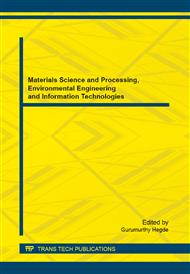p.436
p.440
p.444
p.448
p.451
p.455
p.459
p.464
p.469
Comparison of THMs Formation between Chlorination and Chloramination of Simulated Water with TiO2 and UV Pretreatment
Abstract:
In this study, the formation of trihalomethanes (THMs) during chlorination or chloramination after different pretreatments including single nanoTiO2 adsorption, single UV treatment or the combination of UV/TiO2 under the same pH, TiO2 dose and humic acid concentrations were evaluated. Effect of different pretreatments on the reduction of non-purgeable organic carbon (NPOC) and UV254 before the disinfection was investigated. The result showed that single UV and single TiO2 adsorption to reduce NPOC and UV254 values is negligible, and the combination of UV/TiO2 removed 45% of NPOC and 72% of UV254 after 480min reaction. For the formation of the THMs during the followed chlorination, it was found that the combination pretreatment of UV/TiO2 resulted in a parabolic trend for the formation of the THMs while single UV pretreatment increased steadily and single TiO2 pretreatment kept stable. Chlorination generated higher concentrations of total THMs than chloramination. The total THMs produced by chloramination only represented <5% of that of chlorination.
Info:
Periodical:
Pages:
451-454
Citation:
Online since:
October 2014
Authors:
Price:
Сopyright:
© 2014 Trans Tech Publications Ltd. All Rights Reserved
Share:
Citation:


